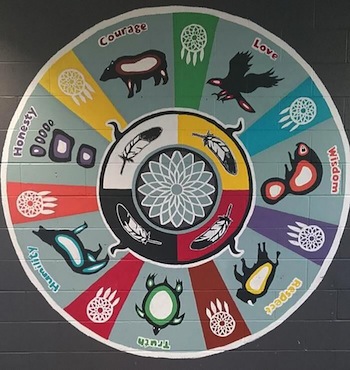In June 2016, it became legal in Canada for a doctor or nurse practitioner to assist someone with their death, as long as they meet certain criteria under the law.
“We’ve been providing this service here ever since,” said Dr. Stefanie Green, who lives and practices in Victoria. “I am one of the medical-assistance-in-dying providers here in British Columbia. Before that, I was primarily a maternity doctor for 20 years, where I took care of babies and newborns.”
As it happened, the Jewish Independent caught up with Green at the end of a day she spent doing circumcisions. The doctor explained that she finds it uniquely interesting dealing with both the beginning and end of life. “There are a lot of similarities to me,” she said. “There’s a lot of overlap in terms of the emotion and skills involved.”
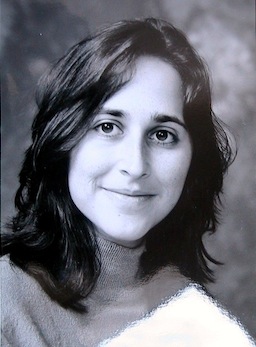
Growing up in Halifax and then doing her medical training in Montreal, Green made her way west almost 15 years ago.
Helping patients die on their own terms has been an increasing part of her practice, with about 70% of people choosing to end their lives at home, and the rest in a care home or hospital.
Medical assistance in dying is only available to people who meet specific criteria in Canada. These criteria include:
- The patient needs to be an adult, over the age of 18.
- The patient doesn’t have to be a Canadian citizen, but they must be eligible for Canadian health-care insurance.
- Patients need to be suffering from what is considered a grievous and irremediable condition; for example, a serious illness, disease or disability in an advanced state that is irreversible, causing unbearable suffering, and, ultimately, leading to the person’s natural death in the foreseeable future.
- The request needs to be made voluntarily; there can be no coercion by family, doctors or anyone else. It has to come directly from the patient and be made by the patient when she/he is capable mentally of doing so.
“If someone is interested, they have to make the request,” said Green. “There’s a specific form in every province that has to be filled out … that has to be witnessed as a legal document.
“Once the request is made legally, then someone like myself – a physician or nurse practitioner – would do an assessment with them, with the family, with the family doctor or specialist, with their records, and make sure they meet the criteria.”
If satisfied at this point, a second assessment is conducted by someone else. Only if both assessments find that the patient meets the criteria, can the patient then be considered eligible and have the power to give the go-ahead if they so choose.
The law stipulates a 10-day waiting period after the request is made before the procedure can happen, unless there are very specific circumstances that require it be otherwise. The procedure itself can be done in one of two ways.
The patients themselves can administer the medication by drinking a liquid the doctor or nurse practitioner provides. The mixture is made by a pharmacy, picked up by the doctor or nurse practitioner, and given to the patient. The nurse practitioner or doctor stands by to ensure all goes smoothly. “It’s not the tastiest of drinks and takes about an hour-and-a-half to be complete,” said Green.
The other option, which more people in Canada are currently choosing, is the physician-administered route. In this case, the doctor picks up the medicine from the pharmacy and brings it to the patient wherever they are. The physician administers it intravenously into an arm and the process takes about 15 minutes.
In the IV procedure, it is a mixture of medications. The first medication is an anti-anxiety medication to relax the patient. Due to its strength, it causes most patients to fall into a light sleep. The second medication is a local anesthetic used to numb the vein being used in order to avoid the chance that it could irritate the patient when the rest of the medication is administered. The third medication moves the patient from a light sleep into a deep sleep and then coma. Many people pass away during that sleep, but not always. The fourth medication paralyzes the body, so if anything is moving, like the respiratory muscles, it will be stopped. The heart will stop soon thereafter.
According to Green, there are a number of countries around the world that have some form of a medical-assistance-in-dying (MAID) team, but Canada is one of only four countries that allows both the patient-administered and physician-administered options.
“I think we allowed it and pushed forward on the law because Canadians feel very strongly that this is a very humane act,” said Green. “It’s something they want to have available.
“What our Supreme Court has decided is that this is actually a constitutional right of Canadians for this care. This is the ability of a physician or nurse practitioner to help someone who wants to end their life at the very end of their life, and who needs help to do so. That’s what this is – a very humane, peaceful and dignified act.
“I think the last poll I saw, 87% of the Canadian public supports this kind of care. I think that this is very respectful of the idea of patient autonomy. That’s what drives this.
“I think that, from an ethical point of view, as a physician, I have the duty to help heal people and to do the best I can to promote healthy life. At the same time, I’m also bound to reduce suffering. There’s a bit of a dichotomy there as a physician. In Canada, the law is reflective of the right of the patient; it’s not about the conflicted duty of the physician.”
From a Jewish perspective, Green does not anticipate any issue from the community. So far, she has done one case within the Jewish community (of a total of 31) and has not had any trouble.
At the time of her interview with the Independent, the MAID program had overseen two to three percent of all deaths on Vancouver Island over the previous six to eight months.
“People ask me a lot about how I feel about this work and what it’s like to do this work,” said Green. “I just want to stress that I do really believe this is a deep privilege to be involved in this care. I feel like I’m helping people. I find it very rewarding at the end.
“I don’t do it for the reward,” she said, “but have been absolutely overwhelmed by the gratitude expressed by the patients I work with and their families. It’s been surprising to me, the extent of that. I want people to know that the service is available and that it’s legal. There are people out there willing to provide this care, and I think it’s a great step forward in Canada. I’m very proud of the work I do.”
Rebeca Kuropatwa is a Winnipeg freelance writer.




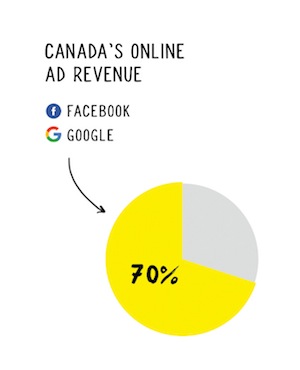 A parliamentary committee was formed. News companies and industry associations queued up with complaints of inequities in the marketplace. The Government of Canada contracted with the PPF, a non-partisan and independent think-tank, to assess the situation and make recommendations on what, if anything, should be done.
A parliamentary committee was formed. News companies and industry associations queued up with complaints of inequities in the marketplace. The Government of Canada contracted with the PPF, a non-partisan and independent think-tank, to assess the situation and make recommendations on what, if anything, should be done. “This report is not about the journalists, with whom I feel great solidarity, but rather the role they play, and what we may be putting at risk if we are inattentive,” writes Edward Greenspon, president and chief executive author of the PPF and the report’s author. Greenspon spent more than 30 years as a journalist before joining the PPF.
“This report is not about the journalists, with whom I feel great solidarity, but rather the role they play, and what we may be putting at risk if we are inattentive,” writes Edward Greenspon, president and chief executive author of the PPF and the report’s author. Greenspon spent more than 30 years as a journalist before joining the PPF.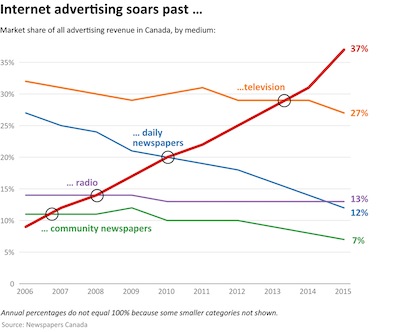 “Google’s share of the Canadian digital market is almost 10 times that of the daily newspaper industry and 60 times that of community newspapers. A comparison of digital revenues for all newspapers and TV programs shows they bring in about one-seventh of the total of the two U.S. platform giants.”
“Google’s share of the Canadian digital market is almost 10 times that of the daily newspaper industry and 60 times that of community newspapers. A comparison of digital revenues for all newspapers and TV programs shows they bring in about one-seventh of the total of the two U.S. platform giants.” Three recommendations deal with CBC’s special role in Canadian news, including a call to relieve the CBC of the need to sell online advertising in order to promote production of civic-function journalism over chasing clicks.
Three recommendations deal with CBC’s special role in Canadian news, including a call to relieve the CBC of the need to sell online advertising in order to promote production of civic-function journalism over chasing clicks.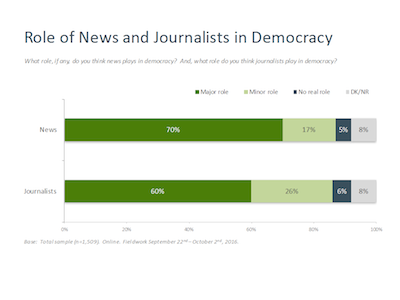 “Never have Canadians had access to more information,” states the report. “But the capacity to produce original news, particularly of a civic nature, is severely constrained by the unsolved riddle of how to finance the cost of journalism in the digital age.”
“Never have Canadians had access to more information,” states the report. “But the capacity to produce original news, particularly of a civic nature, is severely constrained by the unsolved riddle of how to finance the cost of journalism in the digital age.”


